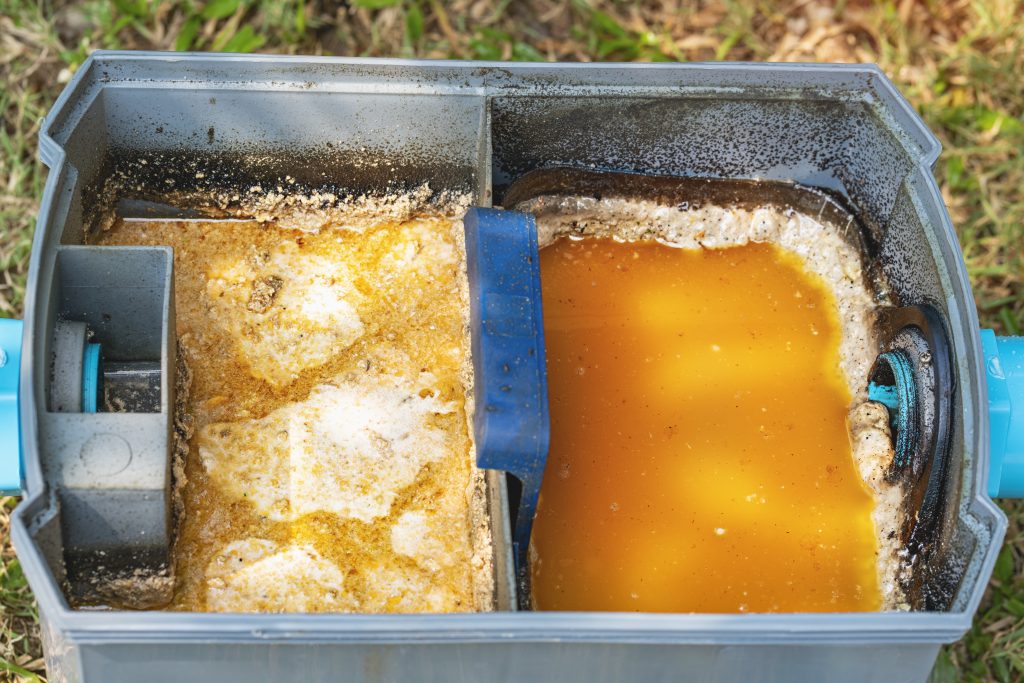

To avoid all these risks, there no better solution but to clean your grease traps every now and then as required. You can clean your grease trap yourself but the operation requires use of some delicate instruments. Hiring a grease trap cleaning company in such as the Grease Company can be much cheaper and we promise to deliver a 100% satisfying results.
Here’s how we clean a grease trap –
Step 1: Removing the seal of the trap: To begin our operation first we carefully remove the seal of the grease trap. If your device is smaller in size we may pry the trap out so that we can remove the grease easily. This step needs to be done slowly and carefully to avoid unwanted damage. We make sure that the gasket under the sink don’t not damaged. The gaskets are responsible for connecting a grease trap to the sink, and if it is damaged, it can be costly to repair.
Step 2: Video Inspection: After the trap is open for us to start working on the inside, we inspect the device with a video camera. This inspection is very important and helps us to find out if there’s already any damage to the inside part of the plumbing device.
Step 3: Measurement of the amount of FOG in the tank: In the next step, we measure the amount of grease, fats, and solids stuck inside the grease trap. We often use a wooden ruler or measurement tape to do this. We make sure that we’re doing it properly so the calculation gets accurate. Then, we record the number in the FOG report.
FOG report is a detailed report that contains all the necessary information like the date of grease trap cleaning, amount of FOG removed, etc. These information’s are essential legal requirement and you’ll need to submit this report the local authority to avoid fines or penalties. So, always make sure that the company you choose for your grease trap cleaning provides you with a detailed work report to ensure you’re compliant.
Step 4: Removing of water and FOGs: After we’re done measuring your grease trap, we shall start cleaning trap. We may use a basket or any other tools to scoop out waters, and junks that floats on top of water. After we’re done removing waters, we focus on the solidified grease. We scrape down the sides of the tank to make sure nothing is left stuck anywhere inside the tank. After removing all the grease from the inside we carefully collect them in sealed facility. When the entire grease trap cleaning operation is completed we take this grease away from your establishment to dump in a proper dumping facility so that they can’t harm the environment.
Step 5: Clean the trap with water: Once all the FOGs are removed and the sludge tank is empty, we clean the trap thoroughly with water. Sometimes, we use soap or detergent to make sure the device is clean as new. We scrub the inside walls of the grease trap to eliminate the last of the FOGs.
This procedure will get rid of all the remaining grime. When we’re finished, we shall remove the water, which will contain grease. So, it won’t be safe to pour it down the sink. If you have screens in the grease traps, you’ll need to remove them. Often, this means that you’ll need to unscrew them. Then, you’ll need to run how water through them, which should melt the grease.
Step 6: Reassemble the Grease Trap: When we done with all the steps mentioned above, we shall reassemble the device. We make sure all the components are fixed accordingly. Grease trap is a complicated device, and any fault in installing or assembling the trap can hamper its effectiveness of working. After reassembling the device, we slot the grease trap back into its place and reconnect the device with kitchen sink.
Step 7: Take away the removed greased to a dumping facility: Grease are toxic elements and very harmful both to human health and the environment. We make sure that the grease we remove from your trap doesn’t get in touch with the environment of your establishment or your neighborhood. We take them away in a sealed facility to a dumpster that allows dumping grease and such toxic elements or to a recycling center (if they are recyclable).
Grease trap cleaning in an essential part of any commercial kitchen plumbing maintenance. The process of cleaning a grease trap can be tricky and intensive. This task requires expert’s attention to be done properly. It is always the best to hire a professional grease trap cleaning company than doing it all by yourself to avoid unwanted damage to your grease trap. If your business is located in California, the Grease Company could be a good choice for your commercial kitchen plumbing. We are experienced and top rated plumbing experts in all of California. Call +1-888-697-8910 today to learn more about us.
